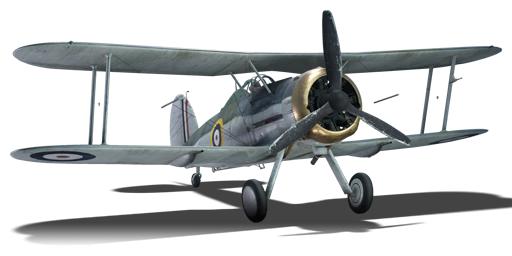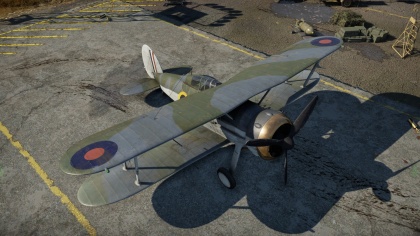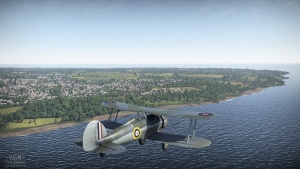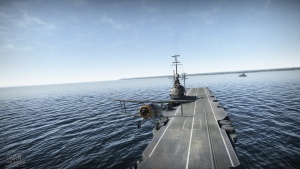Difference between revisions of "Sea Gladiator Mk I"
Colok76286 (talk | contribs) (→Media: Added Shooting Range episode) |
(→Usage in battles) (Tag: Visual edit) |
||
| Line 125: | Line 125: | ||
The '''''{{PAGENAME}}''''' is armed with: | The '''''{{PAGENAME}}''''' is armed with: | ||
| + | |||
* 2 x 7.7 mm Browning .303 machine guns, fuselage-mounted (600 rpg = 1,200 total) | * 2 x 7.7 mm Browning .303 machine guns, fuselage-mounted (600 rpg = 1,200 total) | ||
* 2 x 7.7 mm Browning .303 machine guns, wing-mounted (400 rpg = 800 total) | * 2 x 7.7 mm Browning .303 machine guns, wing-mounted (400 rpg = 800 total) | ||
| Line 134: | Line 135: | ||
There are a couple of issues with the Gladiator, all of which can make it an easy target at times: | There are a couple of issues with the Gladiator, all of which can make it an easy target at times: | ||
| + | |||
* Its power plant configuration, which includes a three-blade fixed-pitch propeller, can make the Gladiator a slug in acceleration and climb. In flight testing the Gladiator can usually only sustain at most around 3,000 fpm (roughly 15 m/s) in a climb at around 180-200 km/h (111-124 mph) indicated airspeed, and its top speed isn't great either (at sea level it can only manage around 335 km/h, and testing has yielded 396 km/h at 4,000 m altitude). | * Its power plant configuration, which includes a three-blade fixed-pitch propeller, can make the Gladiator a slug in acceleration and climb. In flight testing the Gladiator can usually only sustain at most around 3,000 fpm (roughly 15 m/s) in a climb at around 180-200 km/h (111-124 mph) indicated airspeed, and its top speed isn't great either (at sea level it can only manage around 335 km/h, and testing has yielded 396 km/h at 4,000 m altitude). | ||
* The Sea Gladiator manoeuvres well. However, it bleeds a lot of speed in sharp turns, and while its turn radius is good enough to shake off reserve planes, the loss of speed can make the plane a slower and henceforth more vulnerable target to any other enemy planes in the area. Using flaps does help a bit with decreasing the amount of speed lost in a turn, but it is not beneficial enough to allow for minimal loss of speed. And like most early British fighters, it hates high speeds in dives. | * The Sea Gladiator manoeuvres well. However, it bleeds a lot of speed in sharp turns, and while its turn radius is good enough to shake off reserve planes, the loss of speed can make the plane a slower and henceforth more vulnerable target to any other enemy planes in the area. Using flaps does help a bit with decreasing the amount of speed lost in a turn, but it is not beneficial enough to allow for minimal loss of speed. And like most early British fighters, it hates high speeds in dives. | ||
| Line 140: | Line 142: | ||
The Sea Gladiator is outclassed by most of the fighters it comes across. It is inferior in manoeuvrability to the F3F, I-16 and Ki-43, in speed to the 109s, P-40 and CR.42, and in armament to the Bf 109E-3 and P-40E. | The Sea Gladiator is outclassed by most of the fighters it comes across. It is inferior in manoeuvrability to the F3F, I-16 and Ki-43, in speed to the 109s, P-40 and CR.42, and in armament to the Bf 109E-3 and P-40E. | ||
| + | |||
| + | '''Simulator:''' | ||
| + | |||
| + | The Gladiator is a lovely plane to learn with in sim. It can be used in turnfighting and bomber intercepting. Like in AB and RB, it is excellent in turning tightly and continuously, and it has lovely low-speed handling and low stall speeds, making it a great starter plane for Sim. Also it has a decent reflector sight for an early biplane, unlike other early planes with those awful telescope-like sight, which is an advantage in all engagements. However it does have its drawbacks: the rather big nose blocks the visibility a lot, offering very poor over-the-nose visibility which is a disadvantage in a turn fight, because when leading a shot the enemy will always get obstructed by the engine, making the player guess the shot. Also its upper wings and various frames and strings between the wings will get in the way when you look aside. | ||
| + | |||
| + | Note: it is recommended to set the convergence within 300 m, with vertical convergence on, because the majority of turnfights happen at that range or closer. | ||
| + | |||
| + | Before engaging a fight, it is better to have an altitude advantage first. When approaching the fight try to figure out which is your teammate and which is the enemy, to avoid going for a second pass, as the energy retention of the Gladiator is rather slow. Also pick your target carefully. For easier aiming, you want to go for those unmanoeuvrable twin engine aircraft like [[Ju 88 (Family)|Ju 88]] or [[Ki-45 (Family)|Ki-45]], or bombers if there are any. Given the bad forward & sideways visibility of the Gladiator, these are the best options as they are quite slow and sluggish, and are a bigger target to hit. However getting hits on them doesn't mean good damage, so you must be patient. When dealing with fighters, it is way harder to aim. The elevator control of the Gladiator is quite sensitive, giving it good manoeuvrability, but at the same time, bad handling. The Gladiator will respond in a very fast turn upon moving your stick/mouse by a little bit, which makes tracking nimble planes quite hard. But once you get used to it, try to lure every enemy into a turnfight, as that is where the Gladiator shines. Quite a bit of bullets are required to effectively damage the enemy so you must be patient. If you find an enemy at your six, utilise your great turning ability and simply do tight turns, most monoplanes won't be able to cut inside your turn and they might disengage. However with biplanes you will need some defensive manoeuvres like barrel rolls. | ||
=== Manual Engine Control === | === Manual Engine Control === | ||
| Line 197: | Line 207: | ||
'''Pros:''' | '''Pros:''' | ||
| + | |||
* Armament is equal to or better than other fighters in its BR class | * Armament is equal to or better than other fighters in its BR class | ||
* Good manoeuvrability in a turn | * Good manoeuvrability in a turn | ||
| Line 203: | Line 214: | ||
'''Cons:''' | '''Cons:''' | ||
| + | |||
* Sluggish in acceleration and top speed (fixed-pitch propeller can emphasise this problem) | * Sluggish in acceleration and top speed (fixed-pitch propeller can emphasise this problem) | ||
* Performance deficiencies can make it an easy target for experienced or more difficult adversaries | * Performance deficiencies can make it an easy target for experienced or more difficult adversaries | ||
* Not the best climber | * Not the best climber | ||
* Bleeds speed in turns, even when using flaps | * Bleeds speed in turns, even when using flaps | ||
| + | |||
[[File:FighterImage_SeaGladiator takeoff.jpg|thumbnail|right|The Sea Gladiator taking off from a carrier]] | [[File:FighterImage_SeaGladiator takeoff.jpg|thumbnail|right|The Sea Gladiator taking off from a carrier]] | ||
| Line 223: | Line 236: | ||
* ''reference to the series of the aircraft;'' | * ''reference to the series of the aircraft;'' | ||
* ''links to approximate analogues of other nations and research trees.'' --> | * ''links to approximate analogues of other nations and research trees.'' --> | ||
| + | |||
* [https://en.wikipedia.org/wiki/Gloster_Gladiator English Wikipedia article on the Gladiator (all variants)]<br /> | * [https://en.wikipedia.org/wiki/Gloster_Gladiator English Wikipedia article on the Gladiator (all variants)]<br /> | ||
* [http://live.warthunder.com/feed/camouflages/?q=%23seagladiator War Thunder live camouflages for the Sea Gladiator] | * [http://live.warthunder.com/feed/camouflages/?q=%23seagladiator War Thunder live camouflages for the Sea Gladiator] | ||
| Line 228: | Line 242: | ||
== External links == | == External links == | ||
''Paste links to sources and external resources, such as:'' | ''Paste links to sources and external resources, such as:'' | ||
| + | |||
* ''topic on the official game forum;'' | * ''topic on the official game forum;'' | ||
* ''encyclopedia page on the aircraft;'' | * ''encyclopedia page on the aircraft;'' | ||
Revision as of 11:35, 14 June 2020
Contents
| This page is about the British naval fighter Sea Gladiator Mk I. For other versions, see Gladiator (Family). |
Description
The Sea Gladiator Mk I is a rank I British naval fighter
with a battle rating of 1.0 (AB/RB/SB). It was introduced in Update 1.49 "Weapons of Victory".
The Sea Gladiator Mk. I is the last of the Fleet Air Arm biplane naval fighters and, as the name suggests, is a naval modification of the regular Gladiator seen in the RAF tech tree. As a result, its handling characteristics are very similar to said plane type.
General info
Flight performance
Describe how the aircraft behaves in the air. Speed, manoeuvrability, acceleration and allowable loads - these are the most important characteristics of the vehicle.
| Characteristics | |||||||
|---|---|---|---|---|---|---|---|
| Stock | |||||||
| Max Speed (km/h at 4,420 m) |
Max altitude (meters) |
Turn time (seconds) |
Rate of climb (meters/second) |
Take-off run (meters) | |||
| AB | RB | AB | RB | AB | RB | ||
| 400 | 384 | 10211 | 16.8 | 17.9 | 13.1 | 13.1 | 232 |
| Upgraded | |||||||
| Max Speed (km/h at 4,420 m) |
Max altitude (meters) |
Turn time (seconds) |
Rate of climb (meters/second) |
Take-off run (meters) | |||
| AB | RB | AB | RB | AB | RB | ||
| 430 | 414 | 10211 | 15.2 | 16.0 | 18.6 | 15.7 | 232 |
Details
| Features | ||||
|---|---|---|---|---|
| Combat flaps | Take-off flaps | Landing flaps | Air brakes | Arrestor gear |
| X | ✓ | ✓ | X | ✓ |
| Limits | ||||
|---|---|---|---|---|
| Wing-break speed (km/h) |
Gear limit (km/h) |
Combat flaps (km/h) |
Max Static G | |
| + | - | |||
| 520 | ~11 | ~5 | ||
| Optimal velocities | |||
|---|---|---|---|
| Ailerons (km/h) |
Rudder (km/h) |
Elevators (km/h) |
Radiator (km/h) |
| < 240 | < 180 | < 330 | > 190 |
| Compressor (RB/SB) | ||
|---|---|---|
| Setting 1 | ||
| Optimal altitude | 100% Engine power | WEP Engine power |
| 4,100 m | 810 hp | 850 hp |
Survivability and armour
Examine the survivability of the aircraft. Note how vulnerable the structure is and how secure the pilot is, whether the fuel tanks are armoured, etc. Describe the armour, if there is any, and also mention the vulnerability of other critical aircraft systems.
Armaments
Offensive armament
The Sea Gladiator Mk I is armed with:
- 2 x 7.7 mm Browning .303 machine guns, fuselage-mounted (600 rpg = 1,200 total)
- 2 x 7.7 mm Browning .303 machine guns, wing-mounted (400 rpg = 800 total)
Usage in battles
At rank I with a battle rating of 1.0 (AB/RB/SB), this plane will typically be one of the first fighters a new player will research. However, the Sea Gladiator, like its land-based cousin, may be difficult to seek success in, especially in Realistic Battles mode. Within RB, when up-tiering comes into play, it will have to deal with not only biplane adversaries such as the CR.42, F3F and the very manoeuvrable Ki-10, but also more advanced fighters such as the P-40E, Bf 109s, I-16s, and Ki-43s. All these plane types have several varying advantages against the Sea Gladiator, which can make early grinding a bit unbearable for some players.
There are a couple of issues with the Gladiator, all of which can make it an easy target at times:
- Its power plant configuration, which includes a three-blade fixed-pitch propeller, can make the Gladiator a slug in acceleration and climb. In flight testing the Gladiator can usually only sustain at most around 3,000 fpm (roughly 15 m/s) in a climb at around 180-200 km/h (111-124 mph) indicated airspeed, and its top speed isn't great either (at sea level it can only manage around 335 km/h, and testing has yielded 396 km/h at 4,000 m altitude).
- The Sea Gladiator manoeuvres well. However, it bleeds a lot of speed in sharp turns, and while its turn radius is good enough to shake off reserve planes, the loss of speed can make the plane a slower and henceforth more vulnerable target to any other enemy planes in the area. Using flaps does help a bit with decreasing the amount of speed lost in a turn, but it is not beneficial enough to allow for minimal loss of speed. And like most early British fighters, it hates high speeds in dives.
However, the Sea Gladiator has four 7.7 mm (.303) Browning machine guns with a total of 2,000 rounds on hand. The Gladiator's four Browning armament can come in handy at times - when equipped with tracer belts, the plane is capable of taking down even the fiercest of opponents if you play your cards right. A good approach to combat is to attempt to side climb as much as you can on any given map, then use your altitude advantage and turn advantage wisely.
The Sea Gladiator is outclassed by most of the fighters it comes across. It is inferior in manoeuvrability to the F3F, I-16 and Ki-43, in speed to the 109s, P-40 and CR.42, and in armament to the Bf 109E-3 and P-40E.
Simulator:
The Gladiator is a lovely plane to learn with in sim. It can be used in turnfighting and bomber intercepting. Like in AB and RB, it is excellent in turning tightly and continuously, and it has lovely low-speed handling and low stall speeds, making it a great starter plane for Sim. Also it has a decent reflector sight for an early biplane, unlike other early planes with those awful telescope-like sight, which is an advantage in all engagements. However it does have its drawbacks: the rather big nose blocks the visibility a lot, offering very poor over-the-nose visibility which is a disadvantage in a turn fight, because when leading a shot the enemy will always get obstructed by the engine, making the player guess the shot. Also its upper wings and various frames and strings between the wings will get in the way when you look aside.
Note: it is recommended to set the convergence within 300 m, with vertical convergence on, because the majority of turnfights happen at that range or closer.
Before engaging a fight, it is better to have an altitude advantage first. When approaching the fight try to figure out which is your teammate and which is the enemy, to avoid going for a second pass, as the energy retention of the Gladiator is rather slow. Also pick your target carefully. For easier aiming, you want to go for those unmanoeuvrable twin engine aircraft like Ju 88 or Ki-45, or bombers if there are any. Given the bad forward & sideways visibility of the Gladiator, these are the best options as they are quite slow and sluggish, and are a bigger target to hit. However getting hits on them doesn't mean good damage, so you must be patient. When dealing with fighters, it is way harder to aim. The elevator control of the Gladiator is quite sensitive, giving it good manoeuvrability, but at the same time, bad handling. The Gladiator will respond in a very fast turn upon moving your stick/mouse by a little bit, which makes tracking nimble planes quite hard. But once you get used to it, try to lure every enemy into a turnfight, as that is where the Gladiator shines. Quite a bit of bullets are required to effectively damage the enemy so you must be patient. If you find an enemy at your six, utilise your great turning ability and simply do tight turns, most monoplanes won't be able to cut inside your turn and they might disengage. However with biplanes you will need some defensive manoeuvres like barrel rolls.
Manual Engine Control
| MEC elements | ||||||
|---|---|---|---|---|---|---|
| Mixer | Pitch | Radiator | Supercharger | Turbocharger | ||
| Oil | Water | Type | ||||
| Controllable | Not controllable Not auto controlled |
Not controllable Not auto controlled |
Not controllable Not auto controlled |
Separate | Not controllable 1 gear |
Not controllable |
Modules
| Tier | Flight performance | Survivability | Weaponry | |
|---|---|---|---|---|
| I | Fuselage repair | Radiator | Offensive 7 mm | |
| II | Compressor | Airframe | New 7 mm MGs | |
| III | Wings repair | Engine | ||
| IV | Engine injection | Cover | ||
Pros and cons
Pros:
- Armament is equal to or better than other fighters in its BR class
- Good manoeuvrability in a turn
- Tracer belts, like all other planes fitted with Browning machine guns, can be deadly
- Has flaps, unlike most other biplane fighters
Cons:
- Sluggish in acceleration and top speed (fixed-pitch propeller can emphasise this problem)
- Performance deficiencies can make it an easy target for experienced or more difficult adversaries
- Not the best climber
- Bleeds speed in turns, even when using flaps
History
The Gloster Sea Gladiator was, as the name suggests, a naval modification of the Gladiator biplane fighter in use by the Royal Air Force (RAF). Ninety-eight Sea Gladiators were completed: 38 "interim" airframes modified from the existing Gladiator Mk II production line (serial numbers N2265 – N2302), and 60 purpose-built airframes (serial numbers N5500 – N5549 and N5565 – N5574); differences from the Gladiator Mk IIs in service with the RAF included the planes being fitted with catapult attachment points and a tail hook, the airframe being strengthened to withstand carrier landings, and a dinghy lifeboat being made mountable to the underbelly of the plane. As with the Gladiator Mk II it was based off, the Sea Gladiator was powered by a nine-cylinder Bristol Mercury VIIA radial engine rated at 840 hp and mated to a three-blade Fairey metal fixed pitch propeller, and armed with four 7.7-millimeter (.303) Browning machine guns. 54 Sea Gladiators were still in service with the Fleet Air Arm by the time Britain declared war on Germany in September 1939.
Sea Gladiators saw service in the Atlantic aboard Royal Navy carriers, and in the Mediterranean theater during the Siege of Malta.
Media
See also
- English Wikipedia article on the Gladiator (all variants)
- War Thunder live camouflages for the Sea Gladiator
External links
Paste links to sources and external resources, such as:
- topic on the official game forum;
- encyclopedia page on the aircraft;
- other literature.
| Gloster Aircraft Company, Limited | |
|---|---|
| Fighters | Gladiator Mk II · Sea Gladiator Mk I · Gladiator Mk IIF · Gladiator Mk IIS · Tuck's Gladiator Mk II |
| Jet Fighters | Meteor F Mk 3 · Sea Meteor F Mk 3 · Meteor F Mk 4 G.41F · Meteor F Mk 4 G.41G · Meteor F Mk 8 G.41K · Meteor F Mk.8 Reaper |
| Javelin F.(A.W.) Mk.9 | |
| Export | J8A · Iacobi's J8A · ␗Gladiator Mk I · ▄Gladiator Mk I |
| ▄Meteor F Mk.8 · Meteor F.8 · Meteor NF.13 | |
| See Also | Fokker |







